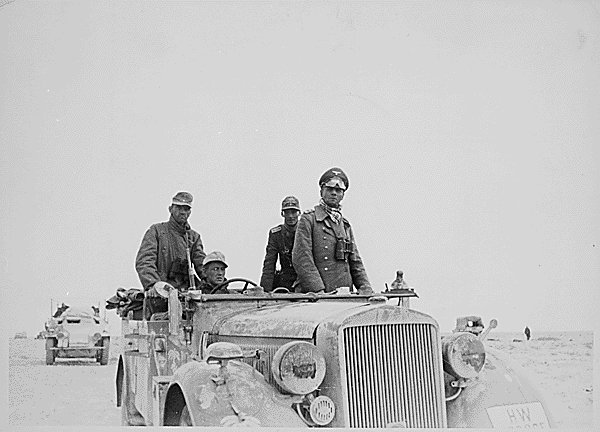Gen. Erwin Rommel in 1941 with the 15th Panzer Division between Tobruk and Sidi Omar, Libya
Erwin Rommel ranks amongst the Second World War's boldest and most innovative, if controversial commanders. Rommel is best known for his exploits in the North African desert from 1941-1943 where he earned his infamous nickname "desert fox" for the elusive and nimble manner in which he frequently deployed his army to confound his British led opponents. Rommel's skilled tactical leadership perplexed a series of British Commanding Generals in North Africa and helped elevate Rommel to a mythological pedestal in the annals of 20th Century military commanders. The British armored expert Basil Liddell Hart even described Rommel's tactical acumen as such as to reach the level of genius.
Nevertheless, in spite of Liddell Hart's effusive praise other analysts, such as American historian Robert Citino, have more correctly noted Rommel was something less than a military genius. Citino singles out Rommel as a hyper aggressive personification of the German military tradition. A military tradition valuing mobile sweeping attacks designed to encircle and destroy more numerous opponents; a tradition that had defined nearly 300 years of Prussian/German military history before Rommel burst upon the scene early in the twentieth century. When examining what Rommel actually accomplished in North Africa other analysts have also put Rommel's accomplishments in a decidedly less glowing light. For example, many, including this author, believes Rommel's decision to expand the North African war proved a disastrous drain on limited Axis resources.
Late in 1940 Hitler, OKH, and the Axis leadership defined Rommel's command in the North African Desert as defensive in nature. Nevertheless, Rommel promptly ignored his orders, and frequently found great success as a result. Regardless, if one critically examines what Rommel actually accomplished in the North African desert, for all of Rommel's 1941-42 maneuvering back and forth across the desert, he only achieved one truly significant victory over the British. Rommel's greatest victory over the British came in the spring of 1942 and cost the manpower sensitive British devastating casualties but at a tremendous cost to Rommel's own position in the Mediterranean theater. Overall, Rommel drew limited Axis resources to a theater of battle that would never have created a positive strategic improvement in the Axis position; at least until the contemporaneously occurring death match against the Red Army was decided.
To Rommel's credit as a leader, he possessed tremendous tactical situational awareness. In part, Rommel's battlefield awareness arose from his belief that in order to act upon decisive opportunities a good commander had to be present on the battlefield. Possessed of a strong will and ceaseless energy Rommel's men picked up on his strength, and devotedly followed him. Rommel also earned his men's respect from his habit of spending ample time at the front; even in personally dangerous situations, exhorting his generals to sweep around British positions and penetrate weak points only discovered through the active reconnaissance Rommel ceaselessly advocated. In turn Rommel demanded much from his men, especially his officers; Rommel frequently commented on the need for officers to exhibit drive and energy. For example, he often berated his commanders for taking too much time when replenishing their diminished fuel and ammunition stores before renewing offensives; speed and mobility served as the essence underlying Rommel's efforts in the desert.
Rommel was a master of mobile warfare. According to Rommel the key to armored operations stood through first, concentrating one's own power, second, splitting the enemy, and third cutting enemy lines of communication. Effective command and control over such operations was essential for victory, demanding the local commander stay close to the front so he could make immediate decisions and attain his objectives by always seeking to achieve surprise, maintain the initiative, and aggressively push any advantage gained as rapidly as possible. Rommel also fully appreciated the value provided from fielding combined arms combat formations and was known in particular for using his armored and anti-tank assets in a coordinated and particularly lethal fashion.
Rommel's tactics, although effective, were not without flaws. Rommel was prone to straying too close to the fighting, frequently leaving his army rudderless, as Rommel was often pinned down under enemy fire or otherwise far removed from his command post. Rommel's constant need to be at the front, although entirely appropriate in a limited fashion when commanding Corps level and smaller formations was not something the leader of an Army or Army Group should do on an overly frequent basis. None other than Manstein himself, a master of the operational art, and virtually peerless commander of formations from Corps up to Army Group level, "understood correctly that command of the largest units required an overall knowledge of the situation and that it required a highly competent staff to be always available to him [the commander]. The commander of the largest units, who lead from the front line, had only a limited view of the position where they happened to be at any given moment."(Marcel Stein, Field Marshal von Manstein, The Janus Head, A Portrait, (Helion & Company, 2007at page 35). In spite of Rommel's failings there is no doubt Rommel ranked amongst the War's best and most talented Corps level leaders.
Picture Courtesy US National Archives, local identifier no. 242-EAPC-6-M713a


